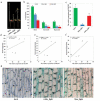Functional analysis of a novel cryptochrome gene (GbCRY1) from Ginkgo biloba
- PMID: 33258712
- PMCID: PMC7849775
- DOI: 10.1080/15592324.2020.1850627
Functional analysis of a novel cryptochrome gene (GbCRY1) from Ginkgo biloba
Abstract
Cryptochrome (CRY) is a blue light receptor that is widely distributed in animals, plants, and microorganisms. CRY as a coding gene of cryptochrome that regulates the organism gene expression and plays an important role in organism growth and development. In this study, we identified four photolyase/cryptochrome (PHR/CRY) members from the genome of Ginkgo biloba. Phylogenetic tree analysis showed that the Ginkgo PHR/CRY family members were closely related to Arabidopsis thaliana and Solanum lycopersicum. We isolated a cryptochrome gene, GbCRY1, from G. biloba and analyzed its structure and function. GbCRY1 shared high similarity with AtCRY1 from A. thaliana. GbCRY1 expression level was higher in stems and leaves and lower in roots, male strobili, female strobili. GbCRY1 expression level fluctuated periodically within 24 h, gradually increased in the dark, and decreased under blue light. The newly germinated ginkgo seedlings were cultured under dark, white light, and blue light conditions. The blue light normally induced photomorphogenesis of ginkgo seedlings, which included hypocotyl elongation inhibition, leaf expansion inhibition, and chlorophyll formation. Treating dark-adapted ginkgo leaves with blue light could induce stomatal opening. At the same time, blue light reduced the expression level of GbCRY1 in the process of inducing photomorphogenesis and stoma opening. Our results provide evidence that GbCRY1 expression is affected by space, circadian cycle and light, and also proves that GbCRY1 is related to ginkgo circadian clock, photomorphogenesis and stoma opening process.
Keywords: CRY1; Ginkgo biloba; blue light; expression.
Figures




Similar articles
-
Molecular cloning of cryptochrome 1 from apple and its functional characterization in Arabidopsis.Plant Physiol Biochem. 2013 Jun;67:169-77. doi: 10.1016/j.plaphy.2013.02.031. Epub 2013 Mar 23. Plant Physiol Biochem. 2013. PMID: 23570872
-
A CRY-BIC negative-feedback circuitry regulating blue light sensitivity of Arabidopsis.Plant J. 2017 Nov;92(3):426-436. doi: 10.1111/tpj.13664. Epub 2017 Oct 9. Plant J. 2017. PMID: 28833729 Free PMC article.
-
Chemical-Induced Inhibition of Blue Light-Mediated Seedling Development Caused by Disruption of Upstream Signal Transduction Involving Cryptochromes in Arabidopsis thaliana.Plant Cell Physiol. 2017 Jan 1;58(1):95-105. doi: 10.1093/pcp/pcw181. Plant Cell Physiol. 2017. PMID: 28011868
-
Signaling mechanisms of plant cryptochromes in Arabidopsis thaliana.J Plant Res. 2016 Mar;129(2):137-48. doi: 10.1007/s10265-015-0782-z. Epub 2016 Jan 25. J Plant Res. 2016. PMID: 26810763 Free PMC article. Review.
-
Stop CRYing! Inhibition of cryptochrome function by small proteins.Biochem Soc Trans. 2022 Apr 29;50(2):773-782. doi: 10.1042/BST20190062. Biochem Soc Trans. 2022. PMID: 35311888 Free PMC article. Review.
Cited by
-
The Gain and Loss of Cryptochrome/Photolyase Family Members during Evolution.Genes (Basel). 2022 Sep 8;13(9):1613. doi: 10.3390/genes13091613. Genes (Basel). 2022. PMID: 36140781 Free PMC article.
-
Identification of a central regulator of ginkgolide biosynthesis in Ginkgo biloba that integrates jasmonate and light signaling.Proc Natl Acad Sci U S A. 2025 Feb 11;122(6):e2408891122. doi: 10.1073/pnas.2408891122. Epub 2025 Feb 4. Proc Natl Acad Sci U S A. 2025. PMID: 39903108 Free PMC article.
References
Publication types
MeSH terms
Substances
LinkOut - more resources
Full Text Sources
Other Literature Sources
